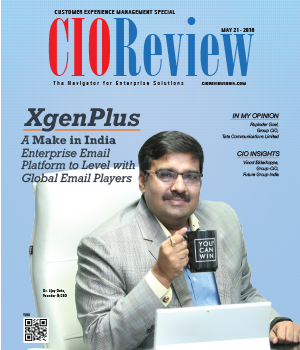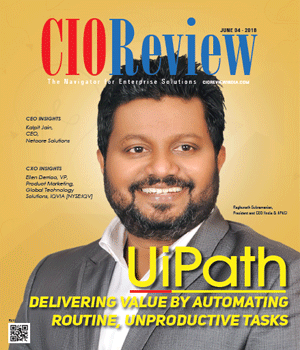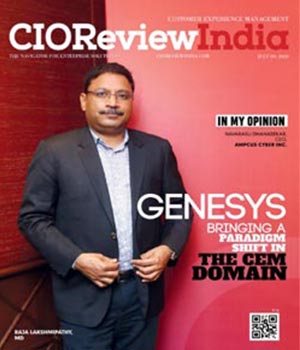
Which Segment of Analytics Space Can Drive the Best Customer Experience?
D. Daniel Ziv, VP Customer Analytics, Verint | Monday, 24 April 2017, 06:07 IST
 The way to maximize your investment in analytics technology is based on how well you leverage your data and insights to make better decisions and take more effective actions. Most successful analytics projects combine several different analytics disciplines including descriptive, predictive and prescriptive analytics.
The way to maximize your investment in analytics technology is based on how well you leverage your data and insights to make better decisions and take more effective actions. Most successful analytics projects combine several different analytics disciplines including descriptive, predictive and prescriptive analytics.
These are defined as follows:
Descriptive Analytics - enables analytics users within an enterprise to query data integrated from multiple applications to create reports, dashboards, or aggregated data that firms access via applications either directly or through APIs.
Predictive Analytics - is about creating predictive models that can predict an outcome with a significant probability of accuracy.
Prescriptive Analytics- is a combination of analytics, math, experiments, simulation, and/or artificial intelligence used to improve the effectiveness of decisions made by humans or by decision logic embedded in applications.
The most effective mix and balance between these different types of analytics is usually dependent on the task, available data, pre-existing knowledge and environment. To help explain further, let’s look at a how one organization made steps toward delivering better customer experience
(Prescriptive Analytics: The Black Belt Of Digital Decisions Build The Last Mile Of Insights-To-Action To Finally Get Value From Investments In Data And Analytics, Forrester, Mike Gualtieri, January 10, 2017)
Putting Analytics to Work—A Customer Example
NPS or Net Promoter Score - is used by many organizations to measure customer experience and advocacy and compare organizations with their peers. With goal in mind, organization should strive to go beyond just measuring their NPS score and use additional forms of analytics to better understand how they can impact and improve their overall customer experience. That is exactly how Firstsource - a large business process outsourcer based in India - looked at the challenge.
The organization learned that its NPS surveys had a response rate of only 2-5 percent and didn’t provide enough actionable insight to inform decisions and actions. With this data in hand, it decided to dive deeper and apply analytics on all the data that was available, including those from recorded customer calls and textual interactions, including free-form survey comments.
This descriptive analytics exercise provided rich insight for understanding the key drivers of customer dissatisfaction. The insights identified various process improvements that led to a $400,000 reduction in unnecessary callbacks, another $400,000 improvement in self-service efficiencies on its IVR and additional $300,000 saved by improving web self-service. This effort also had a significant positive impact on their NPS score and customer satisfaction.
The organization then leveraged what it had learned from the descriptive analytics exercise to go a step further into a predictive analytics experiment. With the low response rate on their NPS surveys, it was concerned that there may be many others within the 95 percent of customers who didn’t respond to any NPS survey that could be detractors or even ‘super detractors’. Super detractors are likely to have a significant negative impact on the overall brand by influencing others to leave or disengage from the company’s products or services.
Firstsource leveraged the rich unstructured data from recorded customer phone calls mined and c a t e g or i z e d with speech analytics, and combined it with a sample of up to 5,000 NPS survey records. The organization then built a model that could predict whether or not a customer is likely to be a super detractor, based on the content of previous phone interactions - even if they never responded to a survey. To extend the effort, the company explored different models, which combined additional structured CRM data and were surprised to find that the call transcription based model of customer calls yielded the best results. Negative emotions expressed in the calls, promised callbacks and multiple repeat interactions were some of the critical elements identified in the call content that helped accurately predict whether or not somebody would become a super detractor.
Armed with this new predictive model, the organization continued on to create a prescriptive model and process to try and recover any possible super detractor. Testing various actions, it created a model that could target the super detractors with the most potential to be converted back to either neutral or promoter status with an effective outreach process. This new prescriptive model achieved a 26 percent successful conversion rate in switching a previous “super detractor” to a neutral—and in some cases even to promoter status.
The Firstsource example illustrates the impact of effective and ongoing descriptive, predictive and prescriptive analytics process. The combination of these different analytics methodologies with the right technology and team can achieve significant impact on customer experience design and delivery, as well as other key organizational metrics.
CIO Viewpoint
How The Sale of Counterfeit Products Can be...
By Khalid Wani, Senior Director, Sales, India- Western Digital
How Customer Experience Is Driving Supply Chain...
By Joseph Lim, Sales Director, APAC, BluJay Solutions
Connect to Customers - Customer Relationship...
By Satrajit Bhattacharya, IT Head, Future Group India
CXO Insights
How Omni-channel Customer Engagement Drives...
By Ankit Tandon, Chief Operating Officer, OYO Townhouse
By In conversation with CIOReview, Krishna Somayaji, MD, Somayaji Group talks about the group of companies
Which Segment of Analytics Space Can Drive the...










